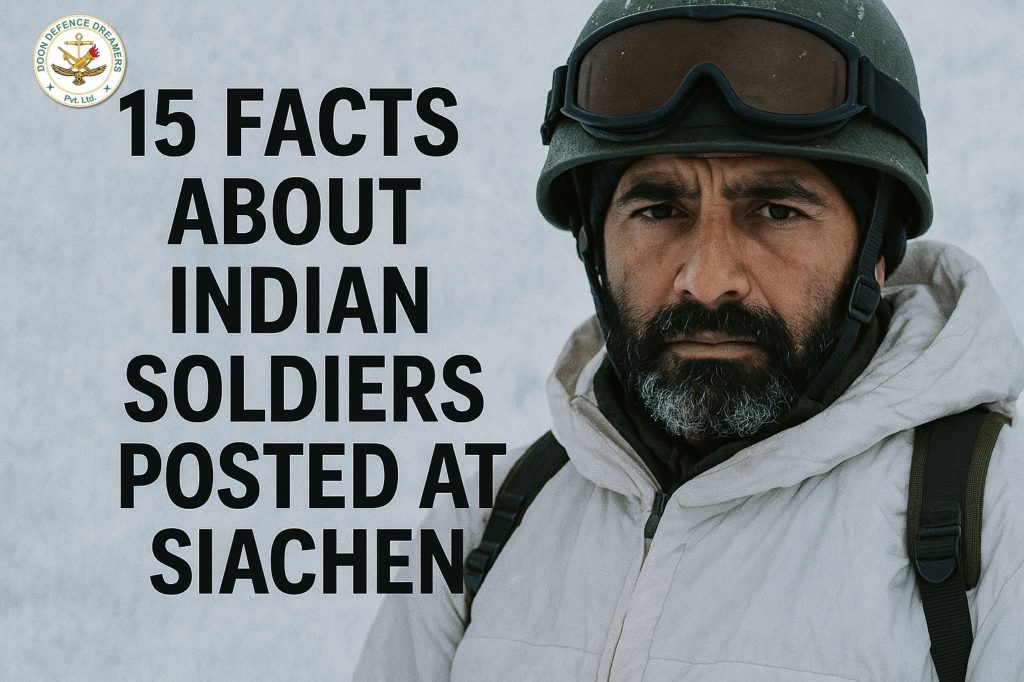Facts About Indian Soldiers Posted at Siachen
Perched in the Karakoram, the Siachen Glacier is often called the world’s highest battlefield—a place where geography is an adversary and routine tasks become feats of endurance. This is a look at fifteen essential facts about life, logistics, risk, and resilience for Indian Soldiers serving there, distilled to help you appreciate what it takes to hold ground in the sky.
The “high-altitude” in high-altitude soldiering
Siachen’s forward posts sit well above 18,000 feet, where oxygen is scarce and every step taxes lungs and legs. Even the fittest troops need staged acclimatization to avoid high-altitude illnesses. That measured build-up—walk-sleep-climb cycles, controlled exertion, and medical monitoring—allows Indian Soldiers to function where most people struggle to stand.
Temperatures that test willpower
Winter windchill can plunge far below freezing, and frostbite risk is ever-present. Extreme cold saps battery life, stiffens metal, and turns simple tools brittle. Troops insulate gear, rotate exposed tasks, and manage sweat carefully, because damp clothing in sub-zero winds becomes a liability within minutes.
Terrain is a living hazard
Glaciers move. Crevasses open without warning, snow bridges conceal voids, and avalanches can roar after a single loud report or temperature shift. Rope discipline, probe drills, and buddy systems are non-negotiable. The mountain doesn’t negotiate; Indian Soldiers adapt.
Logistics is a daily campaign
Helicopter sorties thread narrow weather windows to drop rations, fuel, mail, and medical supplies to posts carved into ice and rock. When airlift is grounded, rationing plans kick in: fuel is prioritized for heat and medical needs, food is stretched, and teams conserve power for communications and navigation.
Clothing is a system, not a jacket
Layering follows a strict logic: moisture-wicking base layers, insulating mid-layers, and weatherproof outer shells, paired with thermal boots, mitts, face masks, and goggles. The goal is to stay warm and dry. Overheat on a climb, and sweat freezes during a halt; that’s why Indian Soldiers fine-tune layers multiple times a day.
Food is fuel, and fuel is survival
Calorie needs soar at altitude. High-energy rations, hot soups, and warm, sweet drinks help maintain core temperature and decision-making. Melting ice for water sounds simple, but it burns precious fuel, so teams plan water production like an engineer plans a bridge.
Training begins long before the glacier
Troops slated for Siachen undergo high-altitude, ice-craft, and survival modules that include crampon work, rope travel, crevasse rescue, casualty evacuation on steep snow, and winterized weapons handling. The curriculum emphasizes judgment as much as technique because Indian Soldiers must choose correctly when visibility collapses and time compresses.
Medical vigilance is constant
From acute mountain sickness to HAPE/HACE risks, medics track oxygen saturation, respiration, hydration, and sleep quality. Early reporting culture is cultivated: the strongest mountaineer can become a casualty if symptoms are ignored. Rapid descent can be lifesaving, which is why contingency evacuation routes are rehearsed like battle drills.
Communications link the heights to home
Line-of-sight radios, satellite links, and redundancy plans keep posts in touch despite snow static and battery drain. Comms discipline—brevity codes, scheduled checks, and power budgeting—preserves bandwidth for critical updates. When a storm isolates a post, the first priority after safety is to tell the net, which reassures families of Indian Soldiers waiting far below. We discuss how technology supports soldiers in extreme conditions in our Defence Knowledge Blogs
Maintenance never sleeps
Weapons must be kept dry and lightly lubricated to avoid freezing actions; optics fog if handled carelessly; generators need cold-weather routines to start; tents, ropes, and anchors are inspected in cycles because failure margins are razor-thin. “Checklists over bravado” is the culture.
Innovation thrives at the edge
Improvised windbreaks, reconfigured stove setups, insulated cable runs, and clever storage hacks reduce heat loss and save fuel. Field ingenuity extends to mental health: small rituals—shared chai at dusk, a five-minute music break, a postcard wall—become anchors. Such habits help Indian Soldiers convert harsh isolation into manageable routine.
Environmental stewardship is deliberate
The glacier is fragile. Waste management, fuel handling protocols, and recovery of non-biodegradables are part of the mission. Melting patterns and weather anomalies are recorded with care because local observation augments forecasts. Indian Soldiers understand they are not only protecting a boundary but also guarding a high-altitude ecosystem.
Rotations balance endurance and expertise
Tenure at the glacier is planned to balance unit cohesion with physiological limits. Crews rotate between forward posts, intermediate camps, and base to reset, train replacements, and move lessons learned downhill. This cadence preserves experience while preventing burnout.
History shapes the ethos
Operations in the 1980s established the current posture on the glacier. That legacy informs a professional ethic centered on preparedness, restraint, and respect for the environment and local communities. The narrative isn’t about conquest; it’s about continuity, duty, and the steady work of watchfulness that Indian Soldiers perform day after day.
Courage looks ordinary up close
Heroism at Siachen often appears as quiet competence: a knot rechecked in a blizzard, a stove coaxed to life at 3 a.m., a calm voice on the radio when a crevasse claims a rucksack. These moments rarely make headlines, yet they define the standard Indian Soldiers set for themselves and the nation.
What these facts mean for the rest of us
Siachen service compresses the fundamentals of soldiering into stark relief: preparation, teamwork, humility before nature, and unshakable discipline. When we read about a supply drop making it through a storm or a patrol navigating blind in spindrift, we’re glimpsing the outcome of systems honed over years—systems that allow Indian Soldiers to succeed where the margin for error is nearly zero.
The human dimension
Letters from home, the crackle of a scheduled radio call, a festival observed with a shared sweet—these are lifelines. Leaders deliberately build small moments of normalcy into the routine because morale is a strategic asset. In extreme environments, mindset is not a buzzword; it’s survival equipment, carried alongside crampons and ropes.
The enduring takeaway
Siachen is a classroom without walls, teaching lessons about resilience that apply far beyond the glacier: break complex problems into checklists, respect the elements, rehearse contingencies, invest in teammates, and measure success by safe returns as much as bold advances. The men and women who serve there remind us that national security is sustained not only by technology and plans but by people willing to show up, day after unforgiving day. That is the quiet power of Indian Soldiers at the top of the world.





























